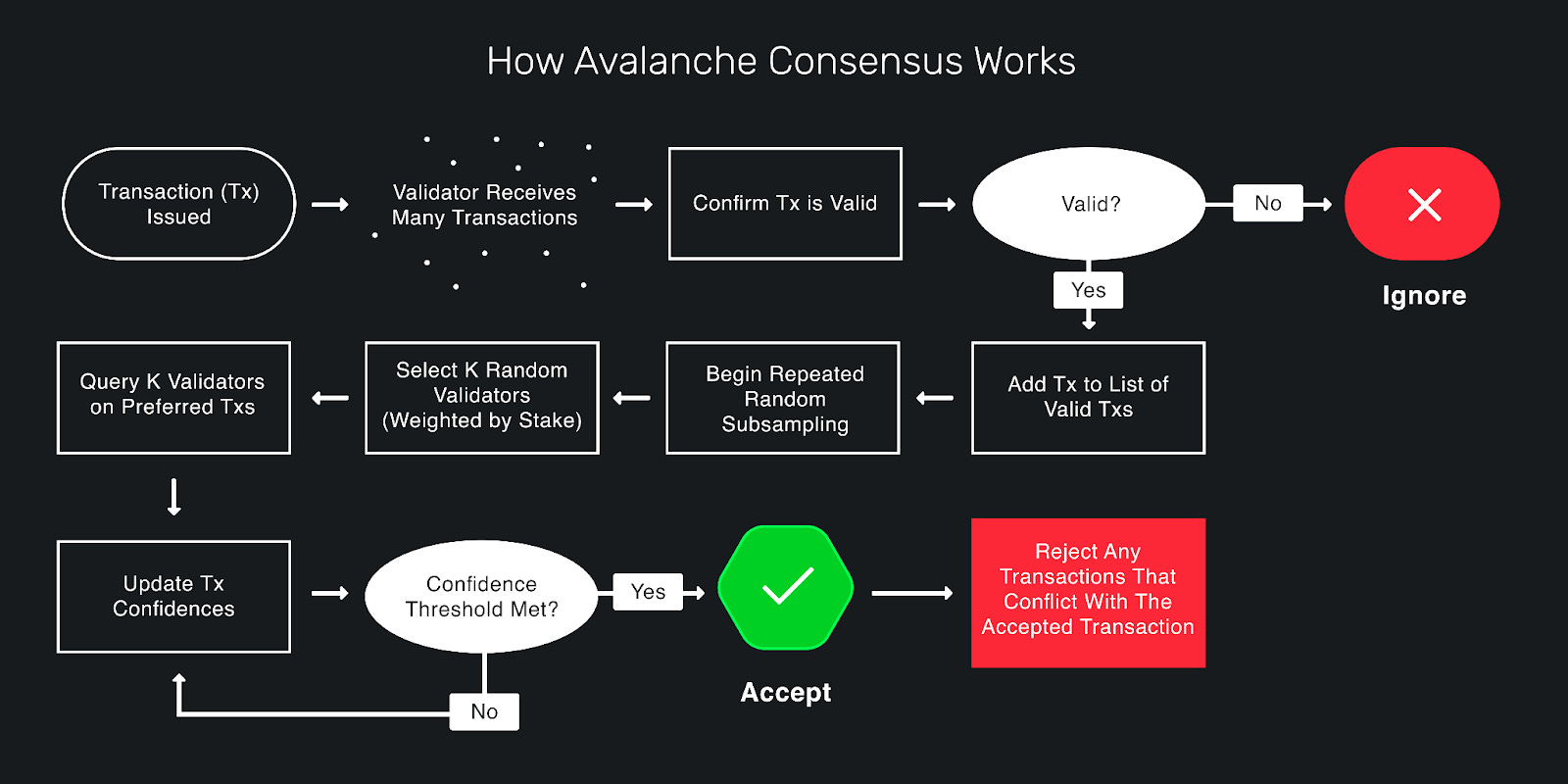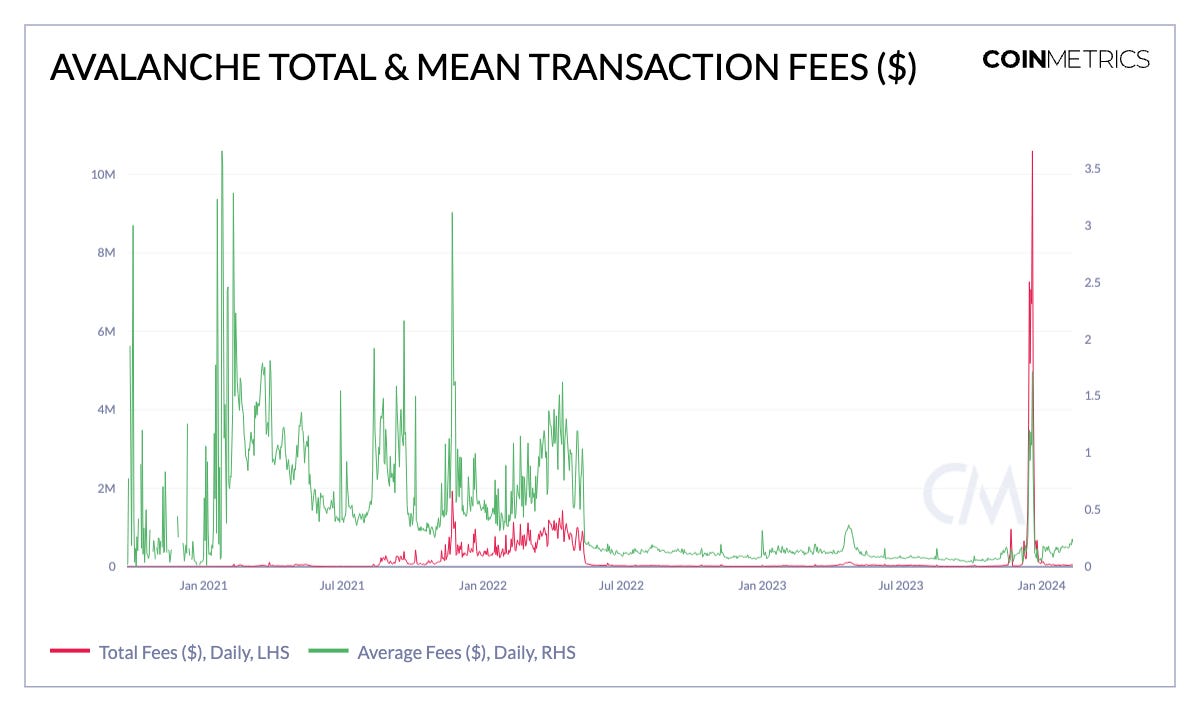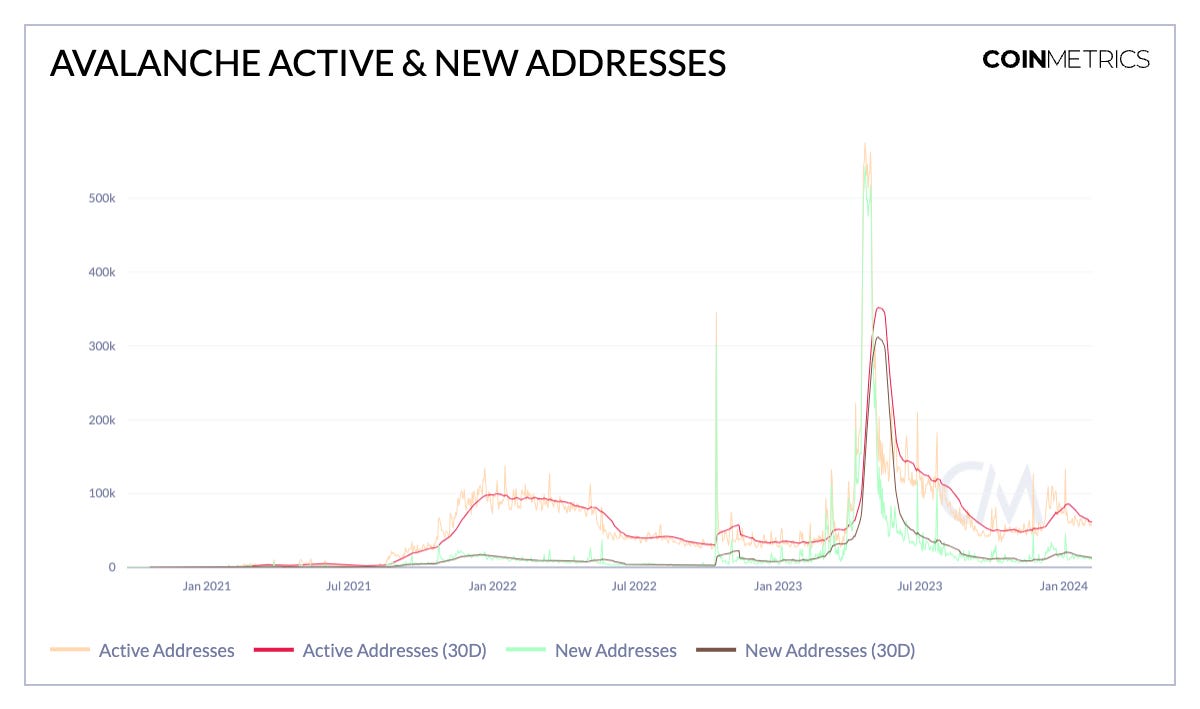Navigating the Avalanche: An Introduction to the Avalanche Network
Navigating the Avalanche: An Introduction to the Avalanche NetworkA data-driven overview of the Avalanche BlockchainGet the best data-driven crypto insights and analysis every week: Navigating the Avalanche: An Introduction to the Avalanche NetworkBy: Tanay Ved & Matías Andrade IntroductionLayer-1 blockchains are the beating heart of the digital asset ecosystem, serving as the foundational infrastructure for the creation and execution of smart contracts. These platforms enable a wide spectrum of applications, ranging from financial services to social media. This landscape has seen a considerable evolution, fostering a diverse ecosystem of layer-1 networks—each presenting distinct advantages while navigating the complex trade-offs between scalability, security and decentralization. At Coin Metrics, our goal is to provide the means to illuminate economic activity underpinning these networks, empowering users to explore their intricacies. With this in mind, we’re excited to have recently added Avalanche network data metrics, enhancing our suite of analytical tools across the digital asset universe. Avalanche plays a pivotal role as one of the leading layer-1 networks within a dynamic and increasingly multi-chain ecosystem. Its unique subnetwork approach, offering customizability, scalability and fast execution supports a vast array of applications—ranging from financial services to digital collectibles. Despite the recent market downturn, Avalanche has continued to grow, attracting developers, retail users and institutions to its three-chain architecture. In this week’s issue of Coin Metrics’ State of the Network, we navigate Avalanche’s role in the digital asset ecosystem. We’ll explore its unique features and highlight the state of the Avalanche network through an array of metrics illuminating adoption and usage characteristics. What is Avalanche & the AVAX Token?Avalanche is a blockchain that leverages a modified proof-of-stake (PoS) mechanism, introduced in 2020 by the Ava Labs team. It is an open source, smart-contract platform for building decentralized apps (dApps) that is Ethereum Virtual Machine (EVM) compatible. Using the unique “Avalanche Consensus,” the network is focused on bringing highly scalable and interoperable infrastructure to the blockchain ecosystem. Ava Labs was cofounded by Emin Gün Sirer, Ted Yin and Kevin Sekniqi—a professor and two doctoral students from Cornell University—in 2018, following their studies in distributed systems and cryptography. In 2003, Emin Gün Sirer published a paper discussing a novel approach to create a P2P cryptocurrency known as Karma, five years before the seminal Satoshi whitepaper. The AVAX token was born during the initial seed round in February 2019, raising $6M for 18M AVAX at $0.33 per token. This was followed by a second private token sale in May 2020 and subsequently a public sale in July 2020, which raised $42M at $0.58 per token. These funding efforts solidified the financial foundation for the Avalanche network and its native token, AVAX. Source: Coin Metrics Network Data AVAX is the native token of the Avalanche ecosystem. It functions as a unit of account, making it a key element for paying transaction fees and securing the network through staking. The maximum supply of AVAX tokens is capped at 720M, with the issuance of remaining tokens allocated towards staking rewards. This is central to Avalanche’s economic model, which aims to balance inflation with validator incentives to maintain network security. AVAX experienced breakthrough success in the prior market cycle, with its market capitalization peaking near $30B in 2021. Despite the overall market downturn, AVAX has regained its momentum—achieving returns of 260% since the beginning of 2023 and a market cap that currently sits around $14.5B—making it the 10th largest digital asset. Understanding Avalanche ConsensusAva Labs' major breakthrough lies in their permissionless and scalable consensus protocol, known as Avalanche Consensus. Unlike Bitcoin and Ethereum which process transactions sequentially in blocks, Avalanche employs a directed acyclic graph (DAG) architecture. This allows for transactions to be processed in parallel rather than linearly, significantly increasing throughput and speed. Avalanche consensus stands out for its permissionless nature, meaning it doesn’t impose a strict limit on the number of validators, unlike other layer-1 solutions like Cosmos or BSC, which limit their active validators to 125 and 21, respectively. Its scalability is enhanced through subsampling, a method that reduces the number of validator votes needed for consensus, enabling the network to finalize transactions very quickly, often in under a second. Sampling allows the validator set to grow while maintaining a relatively constant number of messages that need to be exchanged. This contrasts with Ethereum, where the required communication between validators can rapidly increase as more validators join, potentially slowing down the network. In contrast, the validator set in Avalanche would have to increase from the current ~1750 to around 15,000 before the sampling rounds would have to increase, allowing for permissionless participation in the validation process. Source: Avalanche Consensus Documentation Additionally, Avalanche leverages proof of stake (PoS) to protect against sybil attacks—where a single entity creates numerous fake identities to gain large influence—requiring validators to put up at least 2000 AVAX as collateral. This is analogous to a security deposit, ensuring validators are aligned with the network's health. The system is designed to be leaderless or without a central authority, allowing all staked validators to participate, ultimately enhancing decentralization by broadening the validator set. Avalanche also uses a variant of its consensus protocol known as Snowman Consensus for specific tasks, like managing the validator chain and the EVM chain, which is linear in its operation. Subnets & The Primary NetworkAvalanche’s architecture includes specialized subnetworks, known as ‘subnets’ which are a dynamic set of validators that work together to achieve consensus. They enable the creation of custom networks equipped with specific functionalities and rules to meet diverse needs. Subnets operate as self-governing networks within the larger Avalanche ecosystem and can be composed of their own validator set, specify their own execution logic, fee structures and maintain their own security. Avalanche can be considered as a type of modular blockchain, albeit different from rollups, which achieve vertical scaling by separating functions like consensus, settlement and data availability to specialized layers (i.e., layer-2 rollups settling on Ethereum layer-1). Instead, Avalanche divides its main network into multiple sub-networks that function autonomously by managing their own consensus, execution and security, achieving horizontal scalability. This mitigates congestion issues since increased traffic for a specific application can be accommodated by subnets, providing additional blockspace and segregating the system’s load during periods of peak demand. Subnets are the foundation for several exciting developments taking place on Avalanche. Their design allows for the creation of highly specialized networks, catering to a wide variety of purposes from decentralized finance (DeFi) and gaming to private enterprise blockchains and regulatory compliant systems making them an increasingly popular choice for traditional financial institutions. Avalanche mainnet is referred to as the “Primary Network”—a subnet running three blockchains:
Source: Coin Metrics Network Data The transaction activity across Avalanche’s three chains further contextualizes their distinct roles. The C-Chain, serving as the base for smart contract operations and frequent user interactions, consistently registers the highest transaction count. After peaking above 1M transactions in early 2022, activity tapered off mirroring the wider industry’s downturn. However, by May 2023 activity rebounded to over 500k daily transactions. The influx of inscriptions—initially originating on Bitcoin—also contributed to a surge in activity, culminating in a record 6.3M daily transactions in November. In contrast, transactions on the P-Chain exhibit a distinct behavior, characterized by validator operations such as staking reward payouts. Delegators receive staking rewards for locking their AVAX tokens with validators for a period of 14 to 365 days, creating a cyclical transaction pattern that emerges upon the completion of the staking period. Source: Coin Metrics Network Data The X-Chain is particularly suitable for transferring AVAX tokens in a fast and cost effective manner. As evident in the chart above, the X-Chain demonstrates the largest mean transfer value, implying its use for high value transfers. It also enables the transfer of assets between subnets, enhancing interoperability and flexibility of asset movement within the Avalanche network. Fee Structure & Network AdoptionTransaction fees on the Avalanche network are composed of a similar structure to Ethereum’s EIP-1559, consisting of a base fee and a priority fee (known as a ‘tip cap’). While base fees are dynamic and fluctuate based on the utilization of blockspace, the priority fee is an additional amount that users can pay to have their transactions processed faster. Both types of fees are paid in AVAX and are burned rather than being paid to validators, potentially enhancing the value of AVAX due to increased scarcity. Source: Coin Metrics Network Data Avalanche has experienced periods of significant usage, leading to the variability in average and total fees on the C-Chain. Since June 2022, mean fees on the C-Chain have hovered around $0.10, offering a more cost-effective alternative to chains with higher transaction costs. However, fueled by the wave of inscriptions, total fees reached an all-time high of $10.5M, while average fees were driven up to $1.7 in December 2023—showcasing the impact of high blockspace demand on transaction fees. The X-Chain, on the other hand, has maintained a mean transaction fee of less than $0.05, enhancing its suitability for managing tokens and associated transfers. Source: Coin Metrics Network Data Driven by its low-cost, scalable, and customizable blockchain architecture, Avalanche has garnered significant adoption. In April 2023, daily active addresses and new addresses on the network surged past 500k, coinciding with heightened interest from notable financial institutions, including WisdomTree, T.Rowe Price, Wellington Management, and Cumberland. These institutions utilized Avalanche's Evergreen subnet, "Spruce," an EVM-based chain featuring a permissioned validator set and a custom gas token, to explore the settlement and trade execution of foreign exchange and interest-rate swaps. This partnership highlights Avalanche's appeal to the financial sector, showcasing its potential to streamline trade settlements and reduce costs. Additionally, Avalanche's involvement in "Project Guardian," alongside J.P. Morgan and other major players, demonstrates its role in facilitating the tokenization of portfolios, offering portfolio managers access to a wider range of funds through interoperable blockchains. These developments are few of many examples showcasing Avalanche's value proposition for financial institutions, aligning with its vision to "Digitize All the World's Assets”. ConclusionAvalanche’s distinctive consensus mechanism and subnet architecture position it uniquely within the layer-1 landscape, addressing the complex tradeoffs of scalability and interoperability. The network's robust usage and adoption metrics reflect its ability to support a diverse range of applications and cater to a wide spectrum of end users. Amplified by its innovative use of subnets, Avalanche has catalyzed a shift towards asset tokenization, laying the groundwork to digitize the world's assets on a unified platform, ultimately enabling more efficient and accessible financial systems. The subnet framework, complemented by essential tools like the Core Wallet, promise to extend Avalanche’s reach into various verticals, thereby enriching its ecosystem and broadening its appeal. As the digital asset landscape shifts towards a multi-chain and interoperable future, Avalanche seems well positioned to play a significant role. To dive further into Avalanche, check out our Network Data metrics & dashboard below Network Data InsightsSummary HighlightsBitcoin and Ethereum added 6% to their market capitalization over the week as BTC rallied over $50K for the first time since December 2021. Circle’s USDC supply also increased by 3%, reaching $24B from a low of $21.8B in November 2023. Subscribe and Past IssuesAs always, if you have any feedback or requests please let us know here. Coin Metrics’ State of the Network, is an unbiased, weekly view of the crypto market informed by our own network (on-chain) and market data. If you'd like to get State of the Network in your inbox, please subscribe here. You can see previous issues of State of the Network here. © 2024 Coin Metrics Inc. All rights reserved. Redistribution is not permitted without consent. This newsletter does not constitute investment advice and is for informational purposes only and you should not make an investment decision on the basis of this information. The newsletter is provided “as is” and Coin Metrics will not be liable for any loss or damage resulting from information obtained from the newsletter. |
Older messages
Ethereum’s Dencun Upgrade
Tuesday, February 6, 2024
Coin Metrics' State of the Network: Issue 245
Conducting the ETH Census
Tuesday, January 30, 2024
The Unexpected Challenge of Calculating Ethereum's Total Supply
Tether’s Ascent: Breaking Down the Dominant Stablecoin's Growth
Tuesday, January 23, 2024
Exploring Tether Supply Growth, Adoption, Usage & Reserves
A Short Guide to Bitcoin On-Chain Data for ETF Newcomers
Wednesday, January 17, 2024
Data on bitcoin adoption, economics, supply, usage, market value
Market Structure on the Cusp of Spot Bitcoin ETFs
Tuesday, January 9, 2024
Exploring Crypto Market Data on the Road to the spot Bitcoin ETF
You Might Also Like
Central African Republic’s CAR memecoin raises scrutiny
Friday, February 14, 2025
Allegations of deepfake videos and opaque token distribution cast doubts on CAR's ambitious memecoin project. ͏ ͏ ͏ ͏ ͏ ͏ ͏ ͏ ͏ ͏ ͏ ͏ ͏ ͏ ͏ ͏ ͏ ͏ ͏ ͏ ͏ ͏ ͏ ͏ ͏ ͏ ͏ ͏ ͏ ͏ ͏ ͏ ͏ ͏ ͏ ͏ ͏ ͏ ͏ ͏ ͏ ͏ ͏ ͏
January CEX Data Report: Significant Declines in Trading Volume Across Major CEXs, Spot Down 25%, Derivatives Down…
Friday, February 14, 2025
According to data collected by the WuBlockchain team, spot trading volume on major central exchanges in January 2025 decreased by 25% compared to December 2024. ͏ ͏ ͏ ͏ ͏ ͏ ͏ ͏ ͏ ͏ ͏ ͏ ͏ ͏ ͏ ͏ ͏ ͏ ͏ ͏
Previewing Coinbase Q4 2024 Earnings
Friday, February 14, 2025
Estimating Coinbase's Transaction and Subscriptions & Services Revenue in Q4 2024 ͏ ͏ ͏ ͏ ͏ ͏ ͏ ͏ ͏ ͏ ͏ ͏ ͏ ͏ ͏ ͏ ͏ ͏ ͏ ͏ ͏ ͏ ͏ ͏ ͏ ͏ ͏ ͏ ͏ ͏ ͏ ͏ ͏ ͏ ͏ ͏ ͏ ͏ ͏ ͏ ͏ ͏ ͏ ͏ ͏ ͏ ͏ ͏ ͏ ͏ ͏ ͏ ͏ ͏ ͏ ͏
ADA outperforms Bitcoin as Grayscale seeks approval for first US Cardano ETF in SEC filing
Friday, February 14, 2025
Grayscale's Cardano ETF filing could reshape ADA's market position amid regulatory uncertainty ͏ ͏ ͏ ͏ ͏ ͏ ͏ ͏ ͏ ͏ ͏ ͏ ͏ ͏ ͏ ͏ ͏ ͏ ͏ ͏ ͏ ͏ ͏ ͏ ͏ ͏ ͏ ͏ ͏ ͏ ͏ ͏ ͏ ͏ ͏ ͏ ͏ ͏ ͏ ͏ ͏ ͏ ͏ ͏ ͏ ͏ ͏ ͏ ͏
AI project trading tips: investment targets and position management
Friday, February 14, 2025
This interview delves into the investment trends, market landscape, and future opportunities within AI Agent projects. ͏ ͏ ͏ ͏ ͏ ͏ ͏ ͏ ͏ ͏ ͏ ͏ ͏ ͏ ͏ ͏ ͏ ͏ ͏ ͏ ͏ ͏ ͏ ͏ ͏ ͏ ͏ ͏ ͏ ͏ ͏ ͏ ͏ ͏ ͏ ͏ ͏ ͏ ͏ ͏ ͏
DeFi & L1L2 Weekly — 📈 Polymarket recorded a new high of 462.6k active users in Jan despite volume dip; Holesky a…
Friday, February 14, 2025
Polymarket recorded a new high of 462600 active users in January despite volume dip; Holesky and Sepolia testnets are scheduled to fork in Feb and Mar for Ethereum's Pectra upgrade. ͏ ͏ ͏ ͏ ͏ ͏ ͏ ͏
DeFi & L1L2 Weekly — 📈 Polymarket recorded a new high of 462.6k active users in Jan despite volume dip; Holesky a…
Friday, February 14, 2025
Polymarket recorded a new high of 462600 active users in January despite volume dip; Holesky and Sepolia testnets are scheduled to fork in Feb and Mar for Ethereum's Pectra upgrade. ͏ ͏ ͏ ͏ ͏ ͏ ͏ ͏
Donald Trump taps crypto advocate a16z’s Brian Quintenz for CFTC leadership
Friday, February 14, 2025
Industry leaders back Brian Quintenz's nomination, highlighting his past efforts at the CFTC and potential to revamp crypto oversight. ͏ ͏ ͏ ͏ ͏ ͏ ͏ ͏ ͏ ͏ ͏ ͏ ͏ ͏ ͏ ͏ ͏ ͏ ͏ ͏ ͏ ͏ ͏ ͏ ͏ ͏ ͏ ͏ ͏ ͏ ͏
⚡10 Tips to Make a Living Selling Info Products
Friday, February 14, 2025
PLUS: the best links, events, and jokes of the week → ͏ ͏ ͏ ͏ ͏ ͏ ͏ ͏ ͏ ͏ ͏ ͏ ͏ ͏ ͏ ͏ ͏ ͏ ͏ ͏ ͏ ͏ ͏ ͏ ͏ ͏ ͏ ͏ ͏ ͏ ͏ ͏ ͏ ͏ ͏ ͏ ͏ ͏ ͏ ͏ ͏ ͏ ͏ ͏ ͏ ͏ ͏ ͏ ͏ ͏ ͏ ͏ ͏ ͏ ͏ ͏ ͏ ͏ ͏ ͏ ͏ ͏ ͏ ͏ ͏ ͏ ͏ ͏ ͏ ͏ ͏ ͏ ͏ ͏
Interview with CryptoD: How He Made $17 Million Profit on TRUMP Coin
Friday, February 14, 2025
Author | WUblockchain, Foresight News ͏ ͏ ͏ ͏ ͏ ͏ ͏ ͏ ͏ ͏ ͏ ͏ ͏ ͏ ͏ ͏ ͏ ͏ ͏ ͏ ͏ ͏ ͏ ͏ ͏ ͏ ͏ ͏ ͏ ͏ ͏ ͏ ͏ ͏ ͏ ͏ ͏ ͏ ͏ ͏ ͏ ͏ ͏ ͏ ͏ ͏ ͏ ͏ ͏ ͏ ͏ ͏ ͏ ͏ ͏ ͏ ͏ ͏ ͏ ͏ ͏ ͏ ͏ ͏ ͏ ͏ ͏ ͏ ͏ ͏ ͏ ͏ ͏ ͏ ͏ ͏ ͏ ͏ ͏ ͏ ͏ ͏








